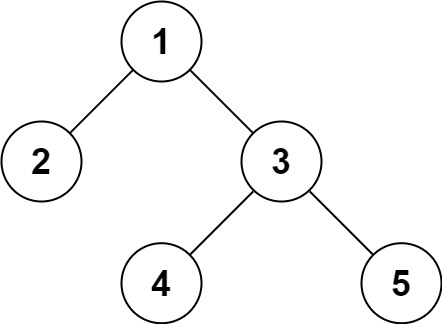
Serialization is the process of converting a data structure or object into a sequence of bits so that it can be stored in a file or memory buffer, or transmitted across a network connection link to be reconstructed later in the same or another computer environment.
Design an algorithm to serialize and deserialize a binary tree. There is no restriction on how your serialization/deserialization algorithm should work. You just need to ensure that a binary tree can be serialized to a string and this string can be deserialized to the original tree structure.
Clarification: The input/output format is the same as how LeetCode serializes a binary tree. You do not necessarily need to follow this format, so please be creative and come up with different approaches yourself.
1
2
3
4
| Example 1:
Input: root = [1,2,3,null,null,4,5]
Output: [1,2,3,null,null,4,5]
|

1
2
3
4
5
6
7
8
9
10
11
12
13
14
| Example 2:
Input: root = []
Output: []
Example 3:
Input: root = [1]
Output: [1]
Example 4:
Input: root = [1,2]
Output: [1,2]
|
Constraints:
- The number of nodes in the tree is in the range [0, 10^4].
- -1000 <= Node.val <= 1000
DFS Solution#
1
2
3
4
5
6
7
8
9
10
11
12
13
14
15
16
17
18
19
20
21
22
23
24
25
26
27
28
29
30
31
32
33
34
35
36
37
38
39
40
41
42
43
44
45
46
47
48
49
50
51
52
53
54
55
56
57
58
59
| /**
* Definition for a binary tree node.
* public class TreeNode {
* int val;
* TreeNode left;
* TreeNode right;
* TreeNode(int x) { val = x; }
* }
*/
public class Codec {
// Encodes a tree to a single string.
public String serialize(TreeNode root) {
StringBuilder sb = new StringBuilder();
dfs(root, sb);
System.out.println(sb.toString());
return sb.toString();
}
void dfs(TreeNode node, StringBuilder sb) {
if (node == null) {
sb.append("#");
sb.append(",");
} else {
sb.append(node.val);
sb.append(",");
dfs(node.left, sb);
dfs(node.right, sb);
}
}
// Decodes your encoded data to tree.
public TreeNode deserialize(String data) {
String[] values = data.split(",");
System.out.println(Arrays.toString(values));
Queue<String> q = new LinkedList<>();
q.addAll(Arrays.asList(values));
return buildTree(q);
}
TreeNode buildTree(Queue<String> q) {
if (q.size() == 0) return null;
String val = q.poll();
if (val.equals("#")) return null;
TreeNode node = new TreeNode(Integer.valueOf(val));
node.left = buildTree(q);
node.right = buildTree(q);
return node;
}
}
// Your Codec object will be instantiated and called as such:
// Codec ser = new Codec();
// Codec deser = new Codec();
// TreeNode ans = deser.deserialize(ser.serialize(root));
|
BFS Solution#
1
2
3
4
5
6
7
8
9
10
11
12
13
14
15
16
17
18
19
20
21
22
23
24
25
26
27
28
29
30
31
32
33
34
35
36
37
38
39
40
41
42
43
44
45
46
47
48
49
50
51
52
53
54
55
56
57
58
59
60
61
62
63
64
65
66
67
68
69
70
71
72
73
74
75
76
77
78
|
/**
* Definition for a binary tree node.
* public class TreeNode {
* int val;
* TreeNode left;
* TreeNode right;
* TreeNode(int x) { val = x; }
* }
*/
public class Codec {
// Encodes a tree to a single string.
public String serialize(TreeNode root) {
StringBuilder sb = new StringBuilder();
Queue<TreeNode> q = new LinkedList<>();
q.add(root);
while (q.size() > 0) {
TreeNode node = q.poll();
if (node == null) {
sb.append("#,");
} else {
sb.append(node.val).append(",");
q.add(node.left);
q.add(node.right);
}
}
// System.out.println(sb.toString());
return sb.toString();
}
// Decodes your encoded data to tree.
public TreeNode deserialize(String data) {
String[] values = data.split(",");
// System.out.println(Arrays.toString(values));
if (values.length == 0) return null;
Queue<TreeNode> q = new LinkedList<>();
TreeNode root = parse(values, 0);
q.add(root);
for (int i = 1; i < values.length; i++) {
TreeNode parent = q.poll();
parent.left = parse(values, i);
if (parent.left != null) {
q.add(parent.left);
}
i++;
parent.right = parse(values, i);
if (parent.right != null) {
q.add(parent.right);
}
}
return root;
}
TreeNode parse(String[] values, int index) {
if (index >= values.length) return null;
String val = values[index];
return val.equals("#") ? null: new TreeNode(Integer.valueOf(val));
}
}
// Your Codec object will be instantiated and called as such:
// Codec ser = new Codec();
// Codec deser = new Codec();
// TreeNode ans = deser.deserialize(ser.serialize(root));
|
